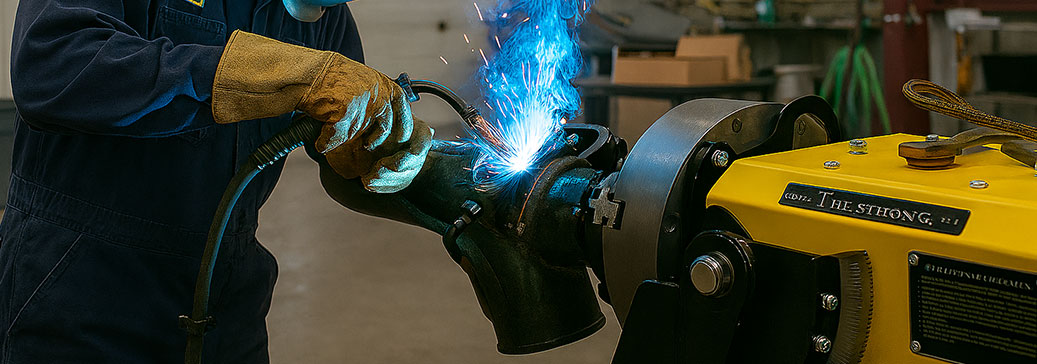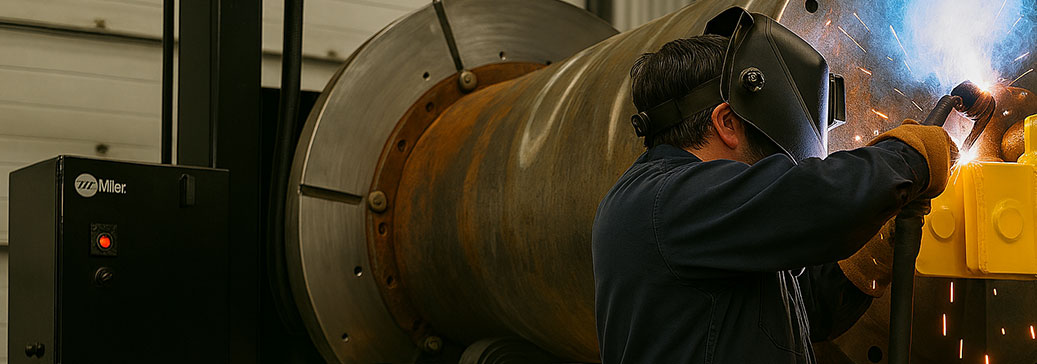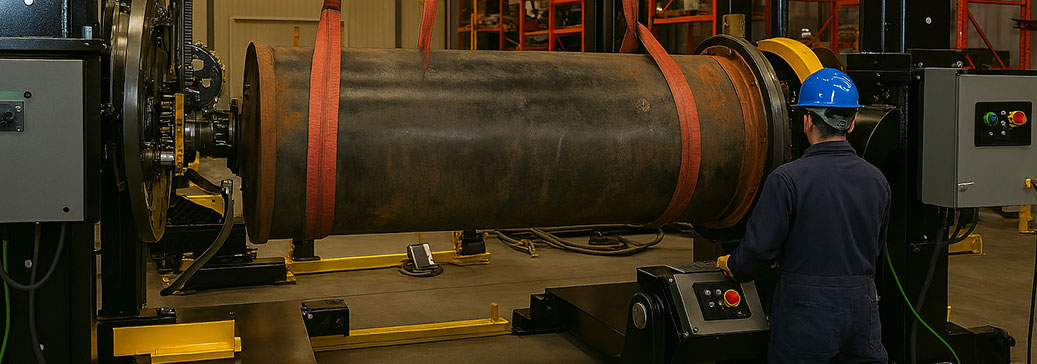A Record of Metal & Flame Welding Blog
More Guides
-
How Can Robotic Welding Transform Fabrication Processes?
Oct 28, 2025, 09:26 AM by Ann McCallum-BolesRobotic welding is reshaping modern fabrication by delivering faster production, lower costs, and higher-quality results. This blog explores how welding automation can streamline your workflow, reduce waste, and elevate product consistency. Whether you're considering a switch or scaling up, discover why robotic welding is a smart investment for competitive manufacturing.Full story -
How Welding Positioners Can Help Improve Productivity, Quality, and Workplace Safety
Aug 14, 2025, 10:53 AM by Ann McCallum-BolesWelding positioners are crucial tools for modern fabrication, improving productivity, quality, and safety. By securely holding and rotating workpieces, they enable welders to create cleaner, more uniform welds, reducing inconsistencies and material waste. These tools also enhance worker safety by minimizing heavy lifting and improving ergonomics. Ultimately, positioners streamline workflows, reduce downtime, and are a key investment for any shop aiming to boost efficiency and consistency.Full story -
What Is Flux Core Welding Wire?
Aug 4, 2025, 11:32 AM by Ann McCallum-BolesFlux-cored welding wires, filled with flux, offer versatility and high deposition rates, making them ideal for industries like shipbuilding, construction, and outdoor repairs. Available in gas-shielded and self-shielded types, they provide strong, reliable welds and are beginner-friendly. Benefits include portability, strength, and adaptability across materials, though slag removal is required. WeldingSupply.com offers an extensive selection and expert guidance to help you choose the right wire for your project and achieve optimal results.Full story -
How to Choose a Plasma Cutter
Jun 17, 2025, 16:56 PM by Ann McCallum-BolesChoosing the right plasma cutter ensures precise, efficient metal fabrication. Key factors include material thickness, which affects amperage needs, input power (115V, 230V, or dual voltage for flexibility), and duty cycle, which determines how long the machine can run before cooling. Portability matters if you work in different locations, while operating costs like consumables impact overall expense. Plasma cutters offer speed, accuracy, and versatility. Find expert tools at WeldingSupply.com!Full story -
The History of Welding
Mar 18, 2025, 16:58 PM by Ann McCallum-BolesWelding is key in today's world. It helps build everything from skyscrapers and ships to airplanes and new medical technology. Welding has greatly influenced humanity and its impact reaches far into the past and over centuries. It highlights our endless quest for innovation and progress. By looking at welding's origins, key milestones, and modern advancements, we see how this craft has influenced society for thousands of years.Full story -
The Benefits of Automated Welding: Revolutionizing Fabrication Processes
Mar 3, 2025, 14:08 PM by Ann McCallum-BolesAutomated welding utilizes machines and computer programs to help make welding faster and more consistent. These systems follow set instructions to complete welding tasks with less help from people, which may reduce errors and improve efficiency. By keeping weld quality more uniform, automated welding can support better results across large projects. While outcomes can vary, many manufacturers use automation to meet production goals and stay competitive.Full story -
Welding Accessories for Beginner Welding
Feb 13, 2025, 09:54 AM by Ann McCallum-BolesThis guide serves as a starting point for beginner welders, detailing the essential tools and accessories required to ensure safety, precision, and efficiency during the welding process. We'll walk you through the key facets of welding—from material preparation and workspace setup to selecting the proper equipment and consumables for different welding methods such as MIG, TIG, and stick welding. We'll also discuss the importance of post-weld cleanup to achieve durable, high-quality results.Full story
How Welding Positioners Can Help Improve Productivity, Quality, and Workplace Safety

Welding positioners enhance fabrication by helping improve weld quality, consistency, and operator safety. They allow precise control over workpiece orientation, helping reduce defects, fatigue, and manual repositioning. By streamlining workflow and minimizing setup time, positioners assist in boosting productivity and reducing material waste. Whether for small shops or industrial-scale operations, they’re a smart investment for efficiency and precision.
This guide is not a replacement for in-person instruction. You should always seek instruction from a qualified trainer. However, here are some tips to help you get started.
Table of Contents:
Improved Weld Quality and Consistency
Helping Protect Worker Safety
Boosting Productivity and Time Efficiency
Reducing Material Waste
Applications and Types of Welding Positioners
Frequently Asked Questions About Welding Positioners
Improved Weld Quality and Consistency
One of the primary benefits of using welding positioners is their ability to help users improve weld quality and consistency. For any welding application,
maintaining the ideal angle and alignment between the welding torch and the workpiece is critical to producing defect-free, high-quality welds. Even experienced welders may struggle to manually maintain ideal positioning for the entire welding process
without assistance, especially on large or complex structures.
Welding positioners can help solve this challenge by enabling greater control over the orientation of the workpiece. By securely holding and rotating the workpiece into
the optimal position, positioners help welders create cleaner, more uniform beads. This can help eliminate common inconsistencies caused by manual repositioning or working at awkward angles, such as:
→ Over- or under-penetration
of welds.
→ Porosity caused by poor torch angle or inadequate shielding gas coverage.
→ Uneven weld bead appearance.
Additionally, welding positioners can help users reduce the risk of distortion
by allowing controlled movement and precision, important for achieving a properly finished product. This is particularly important when producing components that require tight tolerances and consistent quality across every weld. Whether you’re
welding pipes for an industrial pipeline or fabricating a structural component, a positioner can help you improve the accuracy and uniformity of welds.
Helping Protect Worker Safety

A properly selected welding positioner can help users protect worker safety by:
→ Reducing Manual Workloads: Welding positioners can help users avoid the need for heavy lifting and repetitive manual repositioning.
→
Improving Comfort and Ergonomics: Welders can remain in a comfortable and steady position while working on all sides of a component, which can help reduce fatigue.
→ Minimizing Equipment Hazards: A high-quality
positioner can help users avoid makeshift setups or unsafe materials handling techniques.
Boosting Productivity and Time Efficiency
In today’s fast-paced manufacturing world, efficiency is key. Every second saved on a weld adds up, allowing projects to be completed faster and helping fabricators meet tighter production schedules. Welding positioners can help minimize downtime,
streamline processes, and reduce weld cycle times.
→ Seamless Handling of Large Components: Positioners allow individual operators to rotate or tilt large and cumbersome workpieces more easily. This reduces the need
for multiple operators or manual setups, freeing up additional hands for other tasks.
→ Faster Setup Times: Positioners help eliminate the time-consuming need to repeatedly reposition the workpiece using cranes, forklifts,
or other external handling tools. Instead, operators can adjust the workpiece while mounted to a positioner without removing it from the welding station.
→ Simplified Workflow: With positioners, operators spend less
time on logistical challenges—like flipping or rotating components—and more time on actual welding.
For high-volume manufacturers or shops handling repetitive welding tasks, the time savings achieved from using welding
positioners can add up and directly impact your bottom line.
Reducing Material Waste
Quality control plays a crucial role in managing material usage and minimizing costs in manufacturing. Defects in welds, whether caused by poor positioning or operator fatigue, can result in rework, increased material waste, and additional man-hours—all
of which can detract from profitability.
Welding positioners can help fabricators reduce material waste in several ways:
→ More Accurate Welds: With
the workpiece properly oriented, weld beads can be applied with greater consistency. This reduces the incidence of overwelding or missed areas requiring patching or corrections. Less overwelding also means less consumption of filler materials, gases,
and other consumables.
→ Greater Consistency in Repetitive Projects: For jobs requiring multiple identical components, positioners make it easier to replicate high-quality welds across the batch.
→
Minimized Rework: By enhancing the precision of the welding process, positioners can help reduce the need for rework and repairs, saving both materials and labor.
Applications and Types of Welding Positioners

Now that we’ve covered the advantages of welding positioners, it’s also important to understand the range of position types available. Different positioners cater to different applications and are designed to meet the challenges of specific welding processes. Let’s explore some popular types:
Gear Tilt Positioners
Gear tilt positioners are highly versatile, allowing the workpiece to be tilted and rotated in multiple planes. These positioners are widely used in small to medium-scale projects requiring complex positional adjustments for better access to the weld joint.
Pipe Turning Positioners
Designed specifically for pipe and tube work, these positioners rotate cylindrical components, providing a consistent rotation speed for welding. This is especially useful for tasks such as creating circumferential welds on pipe joints.
Headstock and Tailstock Positioners
This type of positioner supports large, heavy components at opposing ends—typically in a horizontal alignment. With adjustable height or rotational capability, these positioners are ideal for welding applications that require extended reach and complete positional control.
Bench-Top Positioners
These compact positioners are designed for smaller and lighter workpieces. Perfect for workshops or smaller-scale operations, bench-top positioners bring precision and flexibility to tasks where space is limited.
Each type
of positioner can be tailored with optional features—such as motorized controls or programmable systems—that can further enhance efficiency and adapt them to specific project requirements. At WeldingSupply.com, we carry positioners suited
to many applications. Let us help you find the right tool for the job.
WeldingSupply.com: Delivering Productivity Solutions
Welding is more than just joining materials—it’s about creating products that meet or exceed expectations. At WeldingSupply.com, we understand the importance of finding the right tools to make your welding processes more productive.
Our wide range of welding positioners covers applications from small bench-top projects to industrial-scale fabrication. By offering high-quality solutions from trusted manufacturers, WeldingSupply.com empowers you to reduce downtime, improve
consistency, and work more efficiently.
Not sure which welding positioner is right for your operation? Our knowledgeable team is here to assist you. Whether you’re upgrading your current equipment or setting up a new workstation,
we’ll help you find the perfect solution to fit your needs.
Conclusion
Incorporating welding positioners into your fabrication processes can be a game changer. By enhancing ergonomics, improving the consistency of welds, and helping you protect your shop environment, these tools boost efficiency while reducing costs. From
industrial-scale manufacturers to smaller workshops, adding a welding positioner is an investment that can deliver measurable benefits in productivity, quality, and safety.
Explore our full range of welding positioners and material
handling solutions at WeldingSupply.com. Let us help streamline your workflows and take your operation to new heights. For questions or personalized recommendations, contact our expert team today.
Shop Welding Positioners →
Frequently Asked Questions About Welding Positioners
What is a welding positioner?
A welding positioner is a specialized piece of equipment that can turn and tilt a workpiece in a consistent position, providing welders optimal access to the weld area. This helps improve weld quality, consistency, and productivity.
What are the key benefits of using a welding positioner?
The main benefits include:-
Improved Weld Quality: Positioners allow for consistent torch and workpiece placement, allowing for more uniform welds.
-
Increased Productivity: Positioners help streamline welding workflows and enable faster completion of projects.
-
Reduced Material Waste: Greater precision minimizes the need for rework, saving on materials and consumables. They also can help reduce filler metal usage by reducing over-welding.
What are the different types of welding positioners?
Common types of welding positioners include:
-
Gear Tilt Positioners: Versatile positioners that can tilt and rotate workpieces on multiple planes.
-
Pipe Turning Positioners: Designed specifically to rotate cylindrical components like pipes and tubes for circumferential welding.
-
Headstock and Tailstock Positioners: Used for supporting large, heavy components at both ends, providing stability and full rotational control.
-
Bench-Top Positioners: Compact units for small, light workpieces in workshops with limited space.
Can a welding positioner be used for any type of welding?
Welding positioners are versatile and can be used for a wide range of welding processes, including MIG, TIG, submerged arc and stick welding. Their primary function is to optimize the workpiece’s position, making the welding process more efficient regardless of the chosen welding method.
How do I know which welding positioner is right for my operation?
The best positioner for you depends on factors like the size and weight of your workpieces, the type of welding you perform, and your available workspace. For large, heavy components, a headstock and tailstock system might be ideal, while smaller-scale shops might benefit from a bench-top positioner. Our team at WeldingSupply.com can help you evaluate your needs and recommend the perfect solution.

